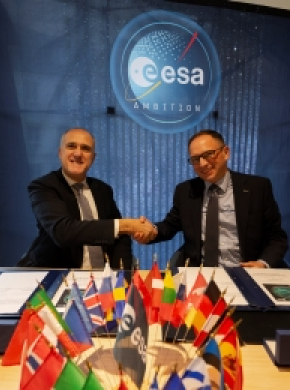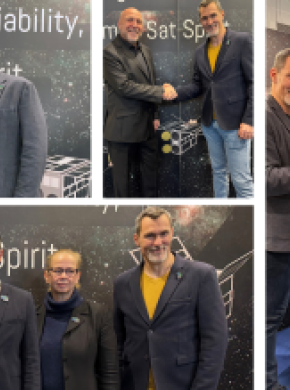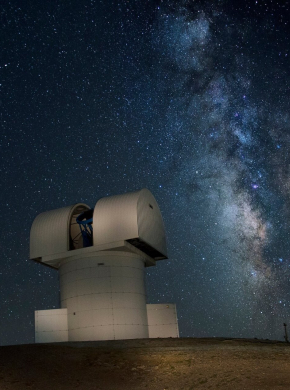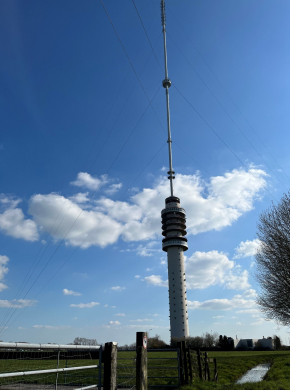Introduction and Context
Global telecommunication systems require networking and optical technologies in order to provide the appropriate tools to address the growing capacity needs of our society. Future telecommunication satellites are to be seamlessly integrated into the terrestrial high-capacity networks, to extend the network in space. This means that large coverage can be achieved, and latency and connection costs can be reduced to remote areas.
Networking in space would benefit from interoperability because it allows the extension of the space network by adding new nodes in a progressive way. The first step of interoperability is compatibility between optical terminals, to make sure that free-space optical links can be established and used for data exchange and control and management purposes.
In recent decades, optical satellite communication has been successfully achieved from different orbits, developing and demonstrating key technologies for high data-rate communications. Throughout this time, several initiatives have focused on the standardisation and specification of optical communications in space, aiming for Interoperability in various scenarios.
The Consultative Committee for Space Data Systems (CCSDS) has been coordinating the initiatives of the space agencies around the world to define a set of standards to cover the main applications using optical communications in space.
- For high-data rate intersatellite links, in December 2018, CCSDS published the experimental specification based on the experience achieved in the European Data Relay System (EDRS): “Optical High Data Rate Communication (HDR) – 1064 nm”.
- For deep-space links, in August 2019, CCSDS published the recommended standard for the Optical Communications Physical Layer where high-photon efficiency is needed.
- For direct downlinks, in July 2020, CCSDS published as pink sheets, the draft of a recommended standard aiming to low-complexity communication systems.
The USA Space Development Agency (SDA) published the "Optical Communications Terminal (OCT) Standard" specifying the main aspects of an optical terminal to achieve interoperability in free-space communications in a satellite constellation.
ESA welcomes this first step towards a global standard, and follows international stakeholders in the desire to extend it beyond the present <10 Gbit/s capabilities.
Overview of ESTOL
The ESTOL specification addresses optical bidirectional inter-satellite and ground-to-satellite links and it is divided into two major chapters: the physical layer requirements and the data link layer requirements.
The objective of ESTOL is to achieve an agnostic definition of requirements in terms of terminal design, to allow industry to develop its own solutions in the most flexible and efficient way.
The physical layer requirements chapter defines:
- The pointing, acquisition, and tracking (PAT)
- The use of multiple wavelengths (WDM-wavelength division multiplexing)
- The requirements of the transmitted signal properties.
For example, the wavelength plan is defined, as well as the modulation schemes and the expected signal levels at the aperture of the optical terminals.
The data link layer requirements chapter defines:
- The data-rates
- The framing
- The forward-error correction schemes for each communication mode.
The different options for transmitting data over the air-interface are defined below, as well as the control and management approach.
The specification of the air-interface includes requirements from the SDA OCT standard, as it is understood that commercial products have been developed following this standard. At the same time, OpenROADM has been also considered because commercial transceivers are implementing this standard for high-data rate fibre communications, allowing the use of both client signals Optical Transport Networking (OTN) and Ethernet. That enables the possibility of performing both circuit and packet switching.
Terabit/sec optical links air-interface
A high-throughput optical satellite network involves optical bidirectional inter-satellite and ground-to-satellite links. Achieving a flexible and scalable network, as addressed in terrestrial networks, requires inter-networking. A generic representation of an optical satellite network, as an extension of the optical terrestrial network is shown in Figure 1.
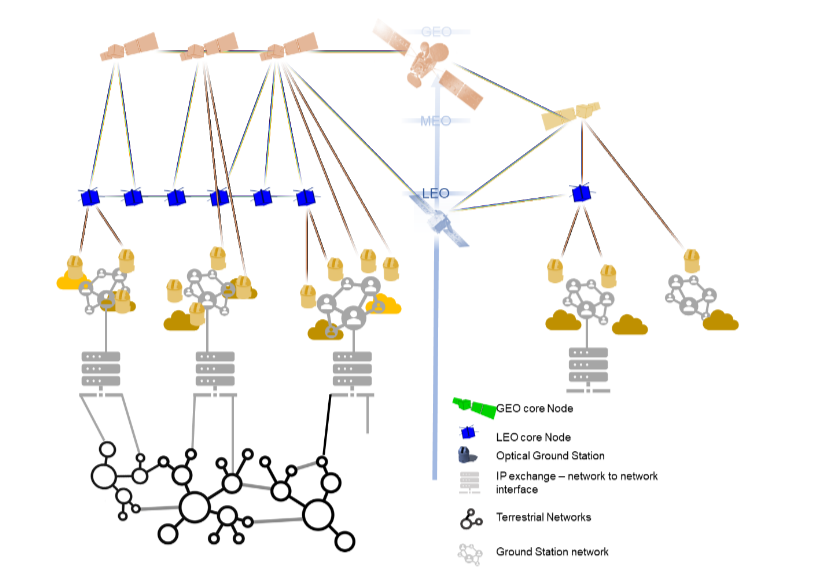
Inter-networking, such as interoperability between networks, must address many different aspects, including:
- Physical interfaces (air- and wired-interfaces)
- Routing protocols
- Addressing schemes
- Naming resolution
- Security mechanisms
Consequently, in view of the future development of high-capacity satellite networks, ESA has supported and coordinated discussions on the definition of the air-interface, specifying the free-space optical links among satellites and ground nodes. This specification shall guarantee compatibility and foster harmonisation of both the technology developments and future commercial products. This is seen as a first step to achieving inter-operability between satellite-based optical networks and terrestrial infrastructure.
Since mid-2022, ESA (under the Strategic Programme Line on Optical and Quantum Technologies) and its stakeholders have also held a series of workshops to assess the interface specifications for next generation optical inter-satellite links and optical space-to-ground links on standards and interfaces.
Stakeholders in these discussions also clearly indicated the need for common standards beyond the air interface. The ESA Specifications for Terabit/sec Optical Links (ESTOL) is the result of the contributions from industry, research centres and universities of ESA Member States, coordinated and aggregated by the Agency.
ESTOL’s goal is to foster the development of interoperable commercial products implementing technologies for high data-rate optical links, connecting ground and space network nodes of optical high-capacity satellite networks. ESTOL aims to make use of available standards from space communications, but also from terrestrial networks, to maximise the re-use of commercially available products.
The High thRoughput Optical Network (HydRON) project takes ESTOL as its point of reference to implement its specification in the development of future satellite networks and their related technologies and it sets as own goal the demonstration of the air-interface defined in ESTOL.
ESTOL’s development was driven by European and Canadian stakeholders in the satellite communications market. The contributors comprise the following industry partners, research centres and universities under the coordination of ESA (in alphabetical order):
- ADTRAN (Germany)
- Aerospacelab (Belgium)
- Airbus Defence & Space (Germany)
- Airbus Defence & Space (France)
- Airbus Defence & Space (Netherlands)
- Archangel Lightworks (United Kingdom)
- Celestia (Netherlands)
- Deutsches Zentrum für Luft- und Raumfahrt (Germany)
- E-S-TEL (Belgium)
- Fraunhofer Henrich Hertz Institute (Germany)
- General Atomics Synopta GmbH (Switzerland)
- Gooch & Housego (United Kingdom)
- GMV GmbH (Germany)
- Honeywell (Canada)
- Joanneum Research (Austria)
- mBryonics (Ireland)
- MPB Communications (Canada)
- Mynaric (Germany)
- Officina Stellare (Italy)
- Rivada Space Networks (Germany)
- Safran Data Systems (France)
- Scuola Superiore Sant’Anna (Italy)
- Spire (United Kingdom)
- Stellar Project (Italy)
- Tesat Spacecom (Germany)
- Thales Alenia Space (Italy)
- Thales Alenia Space (Switzerland)
- TNO (Netherlands)
- Viasat Italy (Italy)
- WORK Microwave (Germany)
ESTOL is being supported by contributors and observers from Japan:
- JAXA Japanese Aerospace Agency (contributor)
- Axelspace (observer)
- Mitsubishi Electric (contributor)
- NEC (observer)
- SpaceCompass (contributor)
Besides, within ESA, the present ESTOL document is a result of a cross-directorate effort with support from the following directorates:
- Directorate of Connectivity and Secure Communications (CSC)
- Directorate of Operations (OPS)
- Directorate of Technology, Engineering & Quality (TEC)
This list is being updated as new contributions from different entities are received.
Versions and current status
The outcome and conclusions of the latest ongoing discussions are collected in the current version of the ESTOL specification. Please note that this is a living document that will evolve with the inputs of the contributors.
The list of all versions with the changes applied is documented in the following table:
|
Version* |
Reason for change |
Date |
|
0.1 |
New document for discussion (internal) |
05/07/2023 |
|
New document on optical intersatellite links |
19/07/2023 |
|
|
1.1 |
PAT update (internal) |
31/07/2023 |
|
2.0 |
Satellite-to-ground links included (internal) |
17/01/2024 |
|
2.1 |
Wavelength plan and sensitivity values update (internal) |
22/03/2024 |
| 2.2 | PAT and sensitivity values update | 01/07/2024 |
*To download the required version of the specification, please click on the relevant link
FEATURED OPPORTUNITIES
NEWS AND EVENTS
ESA signs contract on SAGA mission for sovereign quantum key distribution capability in Europe
The European Space Agency’s (ESA) Security And cryptoGrAphic (SAGA) mission has entered the system definition and preliminary design phase (Phase B2), marking the beginning of the development of the first quantum key sharing mission designed for…
ESA and Japan’s Space Compass Corporation partner to pioneer next-generation optical…
ESA, in partnership with Japanese company, Space Compass Corporation, has signed a Memorandum of Intent (MoI) to jointly conduct the feasibility study for Japan’s LAIDEN project and ESA’s High Throughput Optical Network…
ESA and Austria host world-leading quantum minds to drive space-based quantum information networks…
The European Space Agency (ESA) and the Austrian Research Promotion Agency (FFG) jointly hosted a workshop to address the challenges and opportunities in the interconnection of quantum networks, for example, through future scalable quantum…
The European Space Agency (ESA) has signed a contract with Thales Alenia Space to develop Element #2 of the High-throughput Digital and Optical Network (HydRON) project, marking a significant step forward in space-based optical communications.
ESA supports Estonia’s first industry-led optical communication satellite
ESA is bringing together Hungarian and Estonian space expertise, which will see the development and launch of Estonia’s first commercial satellite.
ESA-Kepler Communications partnership signals start of development phase of HydRON’s LEO ring…
The role of optical communication in space missions continues to gain importance with ESA’s multi-orbit High-throughput Optical Network in Space (HydRON) project, which aims to demonstrate European and Canadian technological maturity as well as…
European Space Agency-funded projects reach new performance level in groundwork for optical…
Telecommunications equipment company, TESAT, and fibre-optic technology leader, MPB Communications, successfully demonstrated a 100 Gigabit per second (Gbps) data at 40 Watts (W) optical output power over a distance of…
In-orbit optical downlink demonstration paves the way for laser satellite communications
A European consortium, primed by Airbus Netherlands (NL), has demonstrated a world-first 9 Gbit/s class, optical downlink from geostationary orbit. Through ESA’s Consolidation of Refinement of Optical Link Architectures…
European space firms set specifications for optical links
Sending vast quantities of data between satellites speedily and securely means using light to communicate. Now a group of space companies, research centres and universities working with ESA has established a series of specifications on how…
ESA-backed TNO consortium establishes first robust optical datalink
A consortium of European industry, led by Dutch firm TNO and backed by the European Space Agency (ESA), has successfully established the world’s first robust optical datalink using real-world conditions in field tests held in the Netherlands.
5th Annual ScyLight Conference points to a bright future for optical and quantum communication
More than 150 attendees including national delegations, industrial representatives of ESA member states, ESA staff members and academic researchers met in Bonn this week for the 5th ScyLight Workshop. This was the first time the event was able to…






